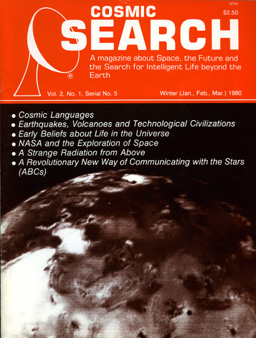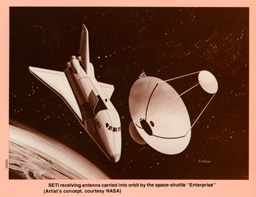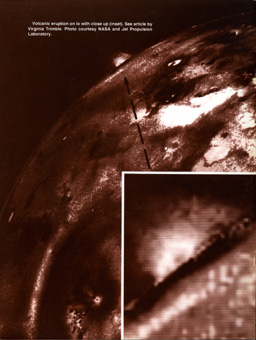Miscellaneous Items
Webpage Table of Contents (Bookmarks)
(Internal links to categories of items in this webpage)
Information About the Publication
(Editorial Board, Editors, Table of Contents)

Editors, and Others Involved in the Publication
Editor: John Kraus, Director, Ohio State University Radio Observatory.
Co-Editor: Mirjana R. Gearhart, Research Astronomer, Ohio State University Radio Observatory.
Co-Editor: Robert S. Dixon, Assistant Director, Ohio State University Radio Observatory
Business Manager: Sylvia Raub
Controller: Lesly Arnold
Assistants: David Raub, Norman Gearhart, Alice Kraus, Harold DeVries, Ann Cole, Janice Kraus, Richard Arnold, Wendy McKenna, Jerry Ehman, Elsa Damon
Editorial Board
- Richard Berendzen, University Provost, The American University
- John Billingham, Director SETI Program, NASA-AMES Research Center
- Ronald Bracewell, Director, Radio Astronomy Observatory, Stanford University
- Thomas A. Clark, NASA-Goddard Space Flight Center
- Arthur C. Clarke, Sri Lanka, author of "2001, A Space Odyssey"
- Norman Cousins, Chairman, Editorial Board, SATURDAY REVIEW
- Frank D. Drake, Director, National Astronomy and Ionosphere Center (Arecibo), Cornell University
- Robert E. Edelson, SETI Project Manager, Jet Propulsion Laboratory, California Institute of Technology
- Donald S. Hall, Director, Strasenburgh Planetarium, Rochester, New York; Past President, International Planetarium Society
- Theodore M. Hesburgh, President, University of Notre Dame
- Nikolai Kardashev, Space Research Institute, Academy of Sciences, Moscow, USSR
- Philip Morrison, Physics Department, Massachusetts Institute of Technology
- Bernard Oliver, Vice President, Hewlett-Packard Company; Director of NASA-Ames Cyclops Project
- Cyril Ponnamperuma, Director, Laboratory of Chemical Evolution, University of Maryland
- Martin Rees, Director, Institute of Astronomy, Cambridge University, England
- Carl Sagan, Director, Laboratory for Planetary Studies, Cornell University
- Walter Sullivan, Science Editor, New York Times
- Vasevolod S. Troitsky, Radiophysical Scientific Research Institute, Gorky, USSR
- Sebastian von Hoerner, National Radio Astronomy Observatory
About COSMIC SEARCH
COSMIC SEARCH is published by Cosmic-Quest, Inc. Copyright © 1979 by Cosmic-Quest, Inc. All rights reserved.
Cosmic Quest, Inc., is a non-profit educational-scientific (tax-exempt) organization dedicated to the promotion and support of SETI endeavors.
Subscription price: $10 for 4 issues in U.S. (and possessions), $13 elsewhere. Single copies: $2.50 in U.S. (and possessions), $3 elsewhere.
Address subscriptions and all other correspondence to: Radio Observatory, Box 293, Delaware, Ohio 43015.
Second-class postage is paid at Delaware, Ohio, and at additional mailing offices.
Telephone: (614) 486-8488
Statement of Ownership, Management and Circulation
[This statement was found on page 27 of the magazine.]
Statement of Ownership, Management and Circulation
Required by U.S. Postal Service (39 U.S. 3685)
(1) Title of Publication: COSMIC SEARCH; Publication No. 485-270. (2) Date of filing: 9-27-79. (3) Frequency of issue: Quarterly; no. of issues published annually: 4; annual subscription price: $10.00. (4) Location of known office of publication: P.O. Box 293, Delaware, Ohio 43015. (5) Location of the headquarters or general business offices of the publishers: Same. (6) Publisher: Cosmic-Quest, Inc., P.O. Box 293, Delaware, Ohio 43015; Editor: Dr. John D. Kraus, P.O. Box 293, Delaware, Ohio 43015; Managing Editor: None. (7) Owner: Cosmic-Quest, Inc., P.O. Box 293, Delaware, Ohio 43015; no
stockholders. (8) Known bondholders, mortgagees and other security holders owning or holding 1 percent of more of total amount of bonds, mortgages or other securities: None. (9) For completion by non-profit organizations authorized to mail at special rates: Tax exempt status received 7-29-79. Status has not changed since that date. (10) Extent and nature of circulation: Ave. (average no. of copies each issue during preceding 12 months), Act. (actual no. of copies of single issue published nearest to filing date; (A) Total no. of copies printed: Ave.: 26,125, Act.: 12,000; (B) Paid circulation, (1) Sales through dealers and carriers, street vendors and counter sales: Ave.: 3,085, Act.: 5,162; (2) Mail subscriptions: Ave.: 2,775, Act.: 3,385; (C) Total paid circulation: Ave.: 5,860, Act.: 8,547; (D) Free samples by mail, carrier or other means (samples, complimentary and
other free copies): Ave: 16,425, Act.: 2,000; (E) Total distribution: Ave.: 22,285, Act.: 10,547; (F) Copies not distributed, (1) Office use, left over, unaccounted, spoiled after printing: Ave.: 3,561, Act.: 1,453; (2) Returns from news agents: Ave.: 279, Act.: These figures will not be available until next issue is published. (G) Total (sum of E, F1 and F2): Ave.: 26,125, Act.: 12,000. (11) 1 certify that the statements made by me above are correct and complete: (Signed) Sylvia Raub, Business Manager. (12) (Signed) John D. Kraus, Editor.
Front Cover

Jupiter's moon to as viewed from Voyager I during its close approach last spring. See article by Virginia Trimble. Photo
courtesy NASA and Jet Propulsion Laboratory.
Table of Contents (in magazine)
| Item | Pg |
|---|
| The Grand Analogy: History of the Idea of Extraterrestrial Life by Trudy E. Bell | 2 |
|---|
| It's a Nice Planet to Visit, but I Wouldn't Want to Live There by Virginia Trimble | 13 |
|---|
| FORUM: Billingham on NASA and the Exploration of Space (an exclusive interview with John Billingham) | 17 |
|---|
| A Strange Radiation from Above by John Kraus | 20 |
|---|
| Stragegies for the Search for Life in the Universe: A Joint Session of the International Astronomical Union by Michael Papagiannis | 24 |
|---|
| Towards a Cosmic Language by Hans Freudenthal | 35 |
|---|
| Features | |
|---|
| Glossary | Front Inside Cover |
|---|
| Letters | 11 |
|---|
| COSMIC SEARCH Awards | 22 |
|---|
| ABCs of SPACE | 28 |
|---|
| Coming in COSMIC SEARCH | 32 |
|---|
| SETI Meetings | 33 |
|---|
| In Review | 34 |
|---|
| SenTInel (SETI News) | 40 |
|---|
| SETI Popular in Colleges | 46 |
|---|
| Thank You to Donors | 47 |
|---|
| Advertiser's Index | 47 |
|---|
| Off the Shelf | 48 |
|---|
|
THANK YOU!
COSMIC SEARCH expresses sincere thanks to the following donors who are helping to make sure that the story of SETI and mankind's future continue to be told in an interesting and factual way.
Planetary Donors
Jane L. Brooks, Adelaide, South Australia (2 years)
David M. Laida, Sierra Vista, Arizona
Arthur J. Morgan, New York, New York
A. V. Shaver, Winchester, Virginia
Paul Simons, Sheboygan, Wisconsin
Dennis Wildfogel, Pomona, New Jersey
COSMIC SEARCH, published by a non-profit scientific-educational organization, has been granted tax-exempt status by the Internal Revenue Service, so contributions are tax-deductible (but subscriptions are not). On a combination donation-subscription or donation-renewal, the amount over and above the magazine cost is tax deductible. For example, if a donor sends $30 (qualifying as a "Planetary Donor") and includes a two-year subscription at $18, the $12 difference is tax-deductible.
Donation categories are as follows:
Planetary: $30 per year
Stellar: $100 per year
Galactic: $500 per year
Cosmic: $1000 per year
Contributions. however, will be gratefully accepted in any amount. Checks should be made payable to Cosmic Quest. Inc., P.O. Box 293, Delaware, Ohio 43015.
|
Coming in COSMIC SEARCH
- "Chief Entities" by I. J. Good
- "Space Travel and Life" by E. J. Öpik
- "Marconi" by George H. Brown
- "Not as We Know It" by Isaac Asimov
- "In the Time Machine" by Don Lago
- "Gravity Waves for Interstellar Communication" by David H. Douglass
- "Strategies of Searching for Extraterrestrial Civilizations" by Nikolai Kardashev
- FORUM: Discussion with Patrick Palmer and Lee Rickart on "SETI Perspectives"
- ABCs of Space will explain in simple terms:
- Signals versus Noise. How to hear what you want amid a lot of noise.
- The Electromagnetic Spectrum. Light, x-rays and radio waves are all the same except for wavelength.
- More SEnTlnel news reports, highlights of meetings, "Off the Shelf" books on Space, the Future and SETI, and many other special features.
Glossary
- Anthropocentric:
- Man-centered.
- Astronomical Unit:
- A unit of length equal to the distance of the earth from the sun, about 150 million kilometers.
- Bandwidth:
- The wavelength or frequency range to which a receiver responds. Bandwidths can be described as narrow or wide, according to their range.
- Big Bang:
- The beginning event in the Universe. The explosion of this primordial fireball some 15 billion years ago caused the initial outward expansion of gas and dust which formed the universe.
- Black Hole:
- An end state of matter of a massive star. Once trapped within the gravitational field of a black hole, nothing can escape.
- CETI:
- An acronym for Communication with Extra-Terrestrial Intelligence.
- Continental drift:
- The geological theory that says continental land masses are moving slowly.
- Cosmology:
- The study of the origin of the universe and how it has developed and what its future will be.
- Electromagnetic radiation:
- Energy which is propagated by changing magnetic and electric fields, and in a vacuum, moving at the speed of light. Electromagnetic radiation covers the entire spectrum from long-wavelength radio radiation to short-wave gamma
radiation.
- Galaxy:
- A large system of stars. Our galaxy, the Milky Way, is a spiral galaxy containing some 100,000 million stars, 100,000 light years in diameter and 10,000 light years thick.
- Gigahertz:
- A unit of frequency equal to 1,000 million hertz.
- Hertz:
- A unit of frequency equal to one cycle per second.
- Hydrogen:
- The most abundant element in the universe. It radiates naturally at a wavelength of 21 centimeters.
- Kelvin degrees:
- Absolute temperature measured in the celsius scale. Ten degrees kelvin equals ten degrees celsius above absolute zero.
- Light-Year:
- The distance traveled by light in one year, about 10 trillion kilometers.
- Light (speed of):
- In empty space: 300,000 kilometers per second.
- Macrocosm:
- The entire universe
- Malthusian:
- Pertaining to political economist Thomas R. Malthus' (1766-1834) contention that population tends to outdistance
its means of support. Eventually population will be held in check by disaster, unless otherwise constrained.
- Megahertz:
- A unit of frequency equal to one million hertz.
- Microcosm:
- The universe in miniature
- Nanosecond:
- One billionth of a second.
- Plate tectonics:
- In geology, relating to the structure of the earth's crust or plates.
- Pulsar:
- A relatively small, rapidly rotating radio source which is believed to have a neutron star at its center.
- Radio Astronomy:
- The science of making astronomical observations using instruments sensitive to radio wavelengths.
- Redshift:
- A shift toward the longer wavelengths of the optical spectrum due to recessional velocity (Doppler effect).
- SETI:
- An acronym for Search for Extra-Terrestrial Intelligence.
- Universe:
- The amalgam of Time, Space, Matter and Energy.
COSMIC SEARCH AWARDS
For best papers on SETI
Category 1. Undergraduate students
Category 2. Graduate students
Category 3. Anyone else under 30 years of age
Papers may be on any aspect of the Search for Extra-Terrestrial Intelligence (SETI). Papers must be double-spaced typewritten with one inch margins on 8 1/2 by 11 inch bond paper and less than 2000 words in length. Any illustrations must be clearly executed.
Authors of best papers will be given a COSMIC SEARCH AWARD of $100 and the paper will be published in COSMIC SEARCH. Authors should include their full address and telephone number. Authors should enclose a self-addressed stamped envelope if they wish to have their manuscripts returned.
Manuscripts may be submitted at any time. Their review is a continuous, on-going process. Each article received is reviewed by a special committee and if judged worthy, either in its original form or after revisions, will be given a COSMIC SEARCH AWARD. The opinion of the committee is final.
A contestant may submit and have under review only one manuscript at a time and be eligible for only one COSMIC SEARCH AWARD in one category. However, it is possible for one person to achieve COSMIC SEARCH AWARDS sequentially in each of the three categories.
Address COSMIC SEARCH AWARD Committee, Radio Observatory, P.O. Box 293, Delaware, Ohio 43015.
Cosmic Calendar
| 15 billion BC | Universe began (BIG BANG) |
| 10 billion BC | Our galaxy formed |
| 5 billion BC | Solar system (sun, earth and other planets) formed |
| 2 million BC | Homo sapiens emerged |
| 5000 BC | Writing invented |
| 1888 AD | Hertz produced radio waves |
| 1903 AD | Letter "S" sent by radio waves across Atlantic Ocean by Marconi |
| 1959 AD | Cocconi and Morrison proposed SETI |
| 1960 AD | First attempt to detect extraterrestrial civilizations by Drake |
| 1979 AD | First issue of COSMIC SEARCH |
Distance Table
Distances in light travel time (approx.)
| Earth to moon | 1 second |
| Earth to sun | 500 seconds (8 min.) |
| Sun to Mars | 12.5 minutes |
| Sun to Jupiter | 40 minutes |
| Sun to Pluto | 5.5 hours |
| Solar system diameter (at orbit of Pluto) | 11 hours |
| Sun to nearest star | 4 years |
| Sun to center of galaxy | 30,000 years |
| Diameter of galaxy | 100,000 years |
| Distance of Andromeda galaxy | 2 million years |
| Distance to "edge" of universe | 15 billion years |
To convert light travel time to kilometers multiply travel time in seconds by velocity of light (300,000 kilometers per second).
Miscellaneous Quotes
The following quotes are not directly associated with any article. They are listed here in the order in which they appear in the magazine; page numbers are given. Uncredited quotes should be credited to the Editors of COSMIC SEARCH magazine.
Quote on page 10
Evolution
A billion years is a long time in evolution; one billion years ago, the highest form of life on the earth was a worm. The intelligent life in other, older solar systems must be as different from us as we are from creatures wriggling in the ooze.
— Robert Jastrow
Quote on page 16
Piano Tops
"I am enthusiastic over humanity's extraordinary and sometimes very timely ingenuities. If you are in a shipwreck and all the boats are gone, a piano top that comes along may make a fortuitous life preserver. But this is not to say that the best way to design a life preserver is in the form of a piano top. I think that we are clinging to a great many piano tops in accepting yesterday's fortuitous contrivings as constituting the only means for solving a given problem."
— Buckminster Fuller in "Operating Manual for Spaceship Earth", E. P. Dutton, 1978.
Quotes on page 32
We Are a Spacefaring People
Our spacefaring could make all the difference. We have been feeling constricted and almost paranoid. But in spacefaring we have found new realms for the human imagination. In the exploration and exploitation of space we may be making the greatest discoveries of all — seeing where we are, appreciating our earthly frailties and finiteness for the first time, and sensing a future that may not be infinite but at least will never again be bound entirely to the cosmic frog pond of Earth.
We are a spacefaring people. — John Noble Wilford
Homo Sap
We have now eliminated a large part of the world's wild life habitats to accommodate our agriculture, our housing, our industries and transportation networks. Is this to continue until no wild species are left? Is this to become virtually a "one-crop" planet — the single crop being Homo Sapiens, exposed to all the epidemic threats that endanger one-crop regimes?
Walter Sullivan in "Continents in Motion"
Quote on page 34
Technology and Thought
So long as we can negotiate the triumph of technology successfully, we are unconcerned to ask what the presuppositions of the technical world are and how they bind us to its framework. Already these presuppositions are so much the invisible medium of our actual life that we have become unconscious of them. We may eventually become so enclosed in them that we cannot even imagine any other way of thought but technical thinking.
William Barrett in The Illusion of Technique: A Search for Meaning in a Technological Civilization
Quotes on page 45
The Nebular Hypothesis
The stars are as thick as flowers in the sky;
Tonight is a night for lovers to kiss;
But we are arguing, you and I,
On the nebular hypothesis.
Mary Burwell
The Best People
The fact that space exploration and space habitation may involve difficulties will constitute a particularly strong challenge to the best nations and the best people.
— Wernher von Braun
Our Technological Civilization
Never have so many people understood so little about so much.
James Burke in "Connections"
Humanism versus Materialism
The humanistic values stated at the founding of our society and the materialistic ones which have predominated throughout our history have often been in conflict. The outcome of the revolution will depend on how that conflict is resolved.
John D. Rockefeller, 3rd, in The Second American Revolution
Quote on page 47
Birds and Stars
If birds among us on this planet
can use the stars to give
direction to their flight,
then maybe birds on planets
very far away use our raging sun
– but only as a tiny hint of light –
to guide their way to home in midst of night.
— Don Lago
Miscellaneous Photos
The following two photos are shown on this webpage at a relatively small size; click on each one to obtain a larger size version.
Photo on Inside Front Cover

Photo on Outside Back Cover

|
![[NAAPO Logo]](../../Images/NAAPOsm.jpg)
![[NAAPO Logo]](../../Images/NAAPOsm.jpg)